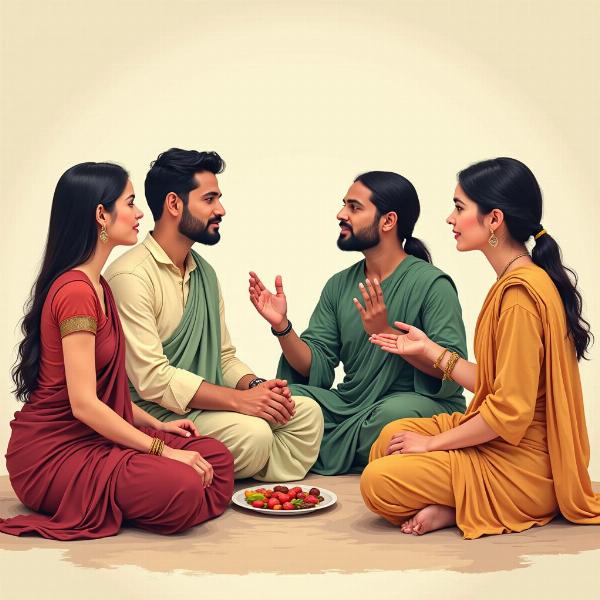Understanding the nuances of translating “do you want to say” into Hindi can be tricky. It’s not a simple one-to-one translation, as the appropriate phrase depends heavily on context, formality, and the specific meaning you want to convey. This guide explores various ways to express “do you want to say” in Hindi, covering different scenarios and cultural considerations to help you communicate effectively.
Different Ways to Say “Do You Want to Say” in Hindi
There isn’t a single perfect translation for “do you want to say” in Hindi. The best choice depends on the situation. Here are some common options:
-
क्या आप कुछ कहना चाहते हैं? (Kya aap kuch kehna chahte hain?): This is a formal and polite way to ask if someone wants to say something. It’s suitable for respectful conversations with elders, superiors, or strangers. It literally translates to “Do you want to say something?”
-
क्या तुम कुछ कहना चाहते हो? (Kya tum kuch kehna chahte ho?): This is an informal version of the above, used with friends, family, and people you’re close to. The “tum” pronoun indicates informality.
-
बोलो, क्या कहना है? (Bolo, kya kehna hai?): This is a more direct and casual way of asking, often used when you expect someone to speak up. It translates to “Speak, what do you want to say?”
-
कुछ कहना है? (Kuch kehna hai?): This is the shortest and most informal version, suitable for close friends and family. It simply means “Something to say?”
Choosing the Right Phrase
The specific context is crucial in selecting the appropriate translation. For instance, in a formal meeting, using “क्या आप कुछ कहना चाहते हैं? (Kya aap kuch kehna chahte hain?)” shows respect and professionalism. However, using this phrase with a close friend might sound overly formal and distant. Conversely, using “कुछ कहना है? (Kuch kehna hai?)” in a professional setting would likely be considered inappropriate.
Cultural Considerations
Indian culture emphasizes respect for elders and authority figures. Therefore, using polite and formal language is generally preferred unless you have a close relationship with the person you’re speaking to. Understanding these cultural nuances will ensure your communication is received positively.
 Cultural Context in Hindi Conversations
Cultural Context in Hindi Conversations
Beyond the Basics: Expressing Specific Intents
Sometimes, “do you want to say” implies a more specific meaning. For example, you might be asking if someone wants to add to a discussion, offer an opinion, or clarify a point. In such cases, consider these phrases:
-
क्या आप इस बारे में कुछ और कहना चाहेंगे? (Kya aap is baare mein kuch aur kehna chahenge?): “Do you want to say anything more about this?”
-
क्या आप अपनी राय देना चाहेंगे? (Kya aap apni rai dena chahenge?): “Would you like to share your opinion?”
-
क्या आप इसे स्पष्ट करना चाहेंगे? (Kya aap ise spasht karna chahenge?): “Would you like to clarify this?”
Practical Examples
Consider these examples to see how these phrases are used in everyday conversations:
-
Formal: A teacher asks a student: “क्या आप कुछ कहना चाहते हैं? (Kya aap kuch kehna chahte hain?)”
-
Informal: A friend asks another friend: “बोलो, क्या कहना है? (Bolo, kya kehna hai?)”
Conclusion
Accurately translating “do you want to say” into Hindi requires understanding the context, level of formality, and the specific nuance you intend to convey. By choosing the right phrase, you can communicate effectively and respectfully within Indian cultural norms. Remember to consider the relationship you have with the person you’re speaking to and the specific situation. This will help you choose the most appropriate and effective way to express yourself. Learning these different phrases will greatly enhance your ability to communicate effectively in Hindi.
FAQ
- What is the most polite way to say “do you want to say” in Hindi? The most polite way is “क्या आप कुछ कहना चाहते हैं? (Kya aap kuch kehna chahte hain?)”
- Can I use “तुम (tum)” with elders? While grammatically correct, using “तुम (tum)” with elders is generally considered disrespectful. It’s safer to use “आप (aap)”.
- What does “kehna” mean? “Kehna” means “to say.”
- Is there a difference between “chahte hain” and “chahte ho”? Yes, “chahte hain” is formal, while “chahte ho” is informal.
- What if I don’t know which phrase to use? It’s always best to err on the side of formality, especially when interacting with strangers or elders.
Meaning-Hindi.in is your trusted partner for professional Hindi translation services. We specialize in various domains, from business and legal documents to technical manuals and website localization. Our expert linguists ensure accurate and culturally sensitive translations, bridging the communication gap between languages. Whether you need document translation, interpretation, or website localization, Meaning-Hindi.in delivers quality and precision. Contact us today for a free quote at [email protected] or call us at +91 11-4502-7584.